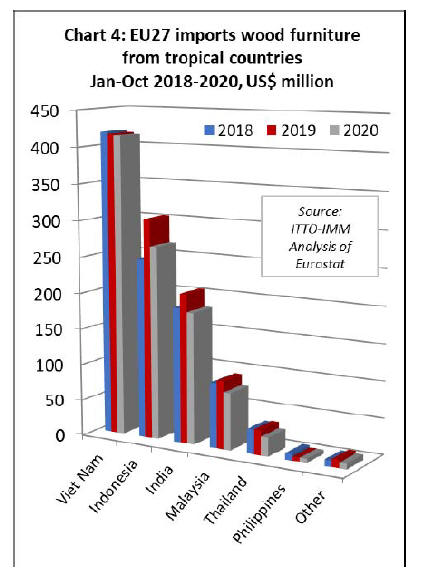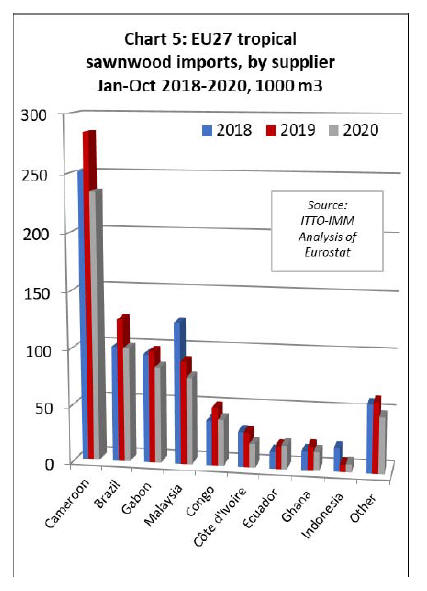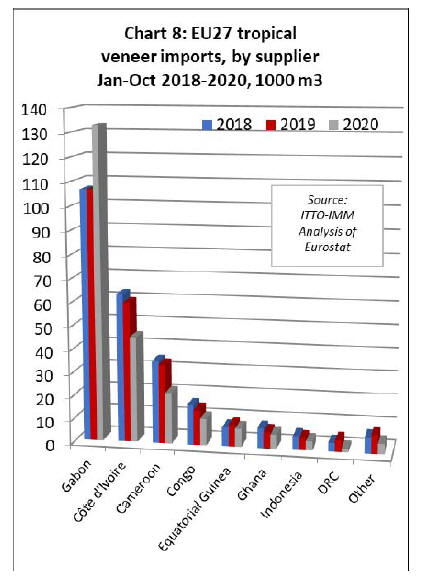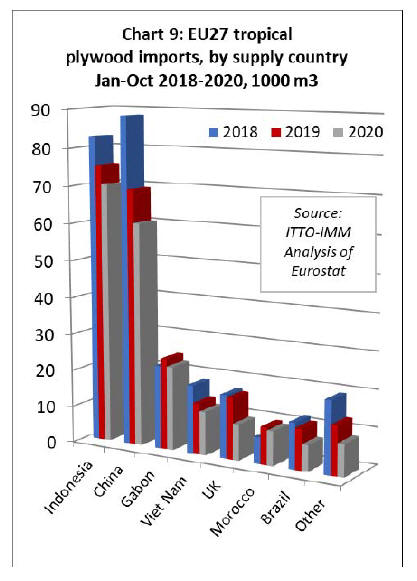|
Report from
Europe
EU tropical timber trade faces double dip recession
Total EU27 (i.e. excluding the UK) import value of
tropical wood and wood furniture products was US$2.48
billion between January and October last year, 12% less
than in 2019.
This is a significantly higher level of import than forecast
earlier in the year when the first waves of the COVID-19
pandemic hit the continent leading to widespread
lockdowns with severe implications for the EU27
economy and on the supply side in tropical countries.
However, with the onset of a second wave of the virus,
and signs that the EU27 is now experiencing a double dip
recession, trade may be receding once again.
Chart 1, which shows the value of EU27 imports of
tropical wood and wood furniture products each month
during the last five years, highlights that while imports fell
sharply in May last year there was a very strong rebound
in June and July. Although imports declined again in
August, they were at a five year high for that month
(which is typically very slow during the European summer
vacation period), and then recovered well in September.
With the easing of lockdown measures from May onwards
and boosted by the introduction of large government
stimulus measures, the economy picked up across the
EU27 in the third quarter.

According to Eurostat, seasonally adjusted GDP in the
EU27 increased by 11.5% during the three month period.
The rebound was almost sufficient to offset the 11.3%
decline in EU27 GDP in the second quarter of 2020.
During this period, EU27 imports were given a boost by
the relative strength of the euro on international exchange
markets, the euro-dollar rate rising sharply from a low of
1.06 in March to 1.22 by the end of the year.
The dollar¡¯s weakness is due to political uncertainty
during and after the presidential elections and the
continuing severity of the pandemic in the United States.
Renewed signs of stress in the EU27 economy
A slight dip in EU27 tropical wood product imports in
October is more worrying as it coincides with renewed
signs of stress in the EU market in the last quarter of 2020.
The second waves of COVID infection across Europe
during the winter months have grown to be significantly
larger than the first waves last year leading to renewed and
more widespread lockdowns.
According to the Oxford ¡°stringency index¡±, which
records the strictness of ¡®lockdown style¡¯ policies to limit
the spread of COVID-19, since mid-October most of
Europe has been subject to restrictions as severe as those
imposed in the first lockdown between March and June
last year. The expectation is that these renewed measures
will be in force in most European countries at least until
mid-February and probably much longer.
Meanwhile, the relative strength of the euro is creating a
headache for the European Central Bank which has
become alarmed at the impact on export competitiveness
of EU27 manufacturers at a time when other factors are
weighing down heavily on demand.
Bloomberg Economics estimates euro-zone GDP fell 1.5%
in the last quarter of 2020, bringing the decline for 2020 as
a whole to 7%. Bloomberg Economics now expects
another 4.1% decline in eurozone GDP in the first quarter
of 2021. Two consecutive quarterly falls is the formal
definition for a recession. The Bloomberg forecast
therefore implies that Europe is in the grips of a ¡°double
dip¡± recession following the downturn already recorded in
the first two quarters of 2020.
However, there have been sizable divergences among EU
member states. Germany has benefited from its greater
reliance on manufacturing, with factories staying open
while government-mandated lockdowns shut non-essential
shops and much of the hospitality sector. Bloomberg
Economics says Europe¡¯s biggest economy probably
managed to post some growth in the fourth quarter and
may have avoided the ¡°double dip¡±. Economists polled by
Reuters in the first week of January now expect German
economic growth to come in at minus 5.1 per cent for the
whole of last year.
European countries like France that are more reliant on
services have been hit harder. The French central bank
reported that the economy likely contracted by 4% in the
final quarter of 2020, which would confirm a previous
estimate that the economy shrank by 9% last year.
Forward looking indicators show that economic
momentum in the EU27 is unlikely to pick up pace in the
first quarter of 2021. The IHS Markit Eurozone PMI
Composite Output Index rose from 45.3 in November to
49.1 in December.
However a score below 50 indicates that a majority of
those surveyed recorded a decline in purchasing during the
month. Services were the principal drag on economic
output, with activity here falling for a fourth successive
month in December. Manufacturing remained the principal
bright spot of eurozone economic performance, expanding
for a sixth successive month and at a faster rate than in
November.
The latest PMI data for eurozone construction is also not
encouraging. IHS Markit, who undertakes the survey,
commented in their 6th January report that ¡°Eurozone
construction companies reported a continued downturn in
activity during December, while incoming business also
fell at a solid, albeit softer pace.
Concerns surrounding the longer term impact that the
pandemic will have on the wider construction sector,
alongside a lack of new projects in both the public and
private sector being bought to tender resulted in an
extension to the pessimistic outlook held by eurozonebased
builders for a fifth month in a row¡±.
IHS Markit noted in relation to individual countries that
¡°France and Germany continued to report further declines
in construction activity, with the former signalling the
steepest fall since May. Italian firms on the other hand
registered marginal growth for the first time since
September.¡±
Most economists now predict that it will be the second
quarter that a recovery in the EU economy ultimately gets
under way. Looking positively, the bounce-back could be
sharp, at least initially, once restrictions are eased and
infections subside, as more of the population is vaccinated.
Pent-up demand could see a chunk of the hundreds of
billions of euros of consumers¡¯ involuntary savings being
unleashed. By the second half of the year, the EU¡¯s
unprecedented 1.8 trillion-euro (US$2.2 trillion) recovery
fund and multi-year budget should be supporting growth.
EU tropical wood product imports down across the
board
Unsurprisingly, EU27 imports of all the main tropical
wood products fell in the first ten months of 2020, but in
each case the decline was less dramatic than expected
earlier in the year when the scale of the pandemic and
associated lockdown measures were becoming apparent.
In the year to October, EU27 import value of wood
furniture from tropical countries declined 8% to US$982
million, while import value of tropical sawnwood declined
16% to US$545 million.
Tropical mouldings were down 18% to US$220 million,
veneer down 10% to US$150 million, joinery down 19%
to US$139 million, plywood down 18% to US$121
million, marquetry and ornaments down 14% to US$58
million, and logs down 21% to US$36 million.
The import value of tropical flooring actually increased
slightly, up 3% to US$52 million (Chart 2).

Import value fell into all six of the largest EU27
destinations for tropical wood and wood furniture products
in the first ten months of the year.

Import value was down 15% to US$502 million in the
Netherlands, 11% in France to US$475 million, 12% in
Germany to US$384 million, 8% in Belgium to US$375
million, 16% in Italy to US$187 million, and 16% in Spain
to US$126 million.
However, import value increased in Denmark, by 19% to
US$113 million, and in Poland, by 12% to US$63 million.
Import value in Sweden declined, but by only 4% to
US$53.3 million (Chart 3 above).
EU27 wood furniture imports from Vietnam close to
last year¡¯s level
In the furniture sector in 2020, EU27 import value from
Vietnam almost matched the previous years¡¯ level in the
first ten months, down only 0.4% to US$415 million.
Imports from Indonesia were down 12% to US267 million
in the first ten months of 2020, although this compares
with a relatively strong performance in 2019 and imports
were still higher than in the same period during 2018
(Chart 4).

EU27 imports of wood furniture declined sharply from
Malaysia and Thailand in the first ten months of 2020,
respectively down 16% to US$79 million and 25% to
US$26 million. However imports from the Philippines
were more stable, falling only 2% to US$5.5 million.
EU27 imports of wood furniture from India were down
12% to US$182 million in the first ten months of 2020.
Partly due to supply side issues, imports from furniture
from India almost came to a complete halt in May last
year, but then rebounded very strongly in the third quarter
to record levels for that time of year.
EU27 tropical sawnwood imports fall 17%
In quantity terms, EU27 imports of tropical sawnwood
declined 17% to 650,800 cu.m in the first ten months of
2020.
Imports fell sharply from all major supply countries; down
18% from Cameroon to 234,600 cu.m, 20% from Brazil to
100,300 cu.m, 14% from Gabon to 84,400 cu.m, 15%
from Malaysia to 76,400 cu.m, 20% from Congo to 40,700
cu.m, 31% from Côte d'Ivoire to 20,900 cu.m, and 22%
from Ghana to 16,400 cu.m.
However, Ecuador bucked the downward trend with EU27
imports of sawnwood from the country rising 6% to
20,700 cu.m, much destined for Denmark and likely
driven by strong demand for balsa for wind turbines.
Imports of sawnwood from Indonesia also increased
slightly, by 9% to 7,100 cu.m, but this follows a 74%
reduction in 2018 (Chart 5).

The decline in imports of tropical sawnwood in the first
ten months of 2020 was mirrored by a similar decline in
EU27 imports of tropical mouldings/decking.

Imports of this commodity were down 11% overall at
143,000 tonnes, falling 7% from Brazil to 64,200 tonnes,
9% from Indonesia to 45,800 tonnes, 15% from Peru to
8,000 tonnes, 15% from Malaysia to 6,600 tonnes, 33%
from Gabon to 4,700 tonnes, and 27% from Bolivia to
4,400 tonnes (Chart 6 above).
EU27 imports of tropical logs were down 21% to 72,400
cu.m in the first ten months of last year. Imports held up
reasonably well from the Republic of Congo, down only
10% to 27,600 cu.m, but fell sharply from all other leading
supply countries including Cameroon (-24% to 10,400
cu.m), Central African Republic (-34% to 11,000 cu.m),
DRC (-41% to 6,500 cu.m), and Liberia (-26% to 5,900
cu.m) (Chart 7).

EU27 tropical veneer imports from Gabon on the rise
despite pandemic
EU27 imports of tropical veneer declined 6% to 235,000
cu.m in the first 10 months of 2020. Imports from Gabon
bucked the wider downward trend, the EU27 importing
133,100 cu.m from the country between January and
October last year, 25% more than the same period in 2019,
mainly destined for France.
Veneer imports declined from all other major tropical
suppliers, including Côte d'Ivoire (-24% to 45,200 cu.m),
Cameroon (-36% to 21,700 cu.m), Equatorial Guinea (-
16% to 7,800 cu.m), Ghana (-14% to 6,000 cu.m),
Indonesia (-24% to 3,900 cu.m) and DRC (-69% to 1,600
cu.m). (Chart 8).

Although there were signs of an uptick in the pace of
EU27 imports of tropical hardwood faced plywood in
September and October last year, total imports of 207,000
cu.m in the first ten months were still down 15%
compared to the same period in 2019.
Imports fell from all the leading supply countries
including Indonesia (-7% to 70,200 cu.m), China (-13% to
60,400 cu.m), Gabon (-8% to 22,700 cu.m), Vietnam (-
15% to 11,700 cu.m), Morocco (-8% to 9,300 cu.m) and
Brazil (-37% to 7,000 cu.m).

EU27 imports of tropical hardwood faced plywood from
the UK ¨C a re-export since the UK has no plywood
manufacturing capacity - declined 41% to 9,700 cu.m
(Chart 9 above).
EU27 tropical flooring imports rise while other joinery
imports decline
Given the situation in the wider market, one of the least
expected trends in EU27 import data was a slight recovery
in imports of tropical flooring products in the first ten
months of last year. This follows a long period of
continuous decline. Imports increased 4% to 20,400
tonnes, with the gain due to a 31% rise in imports from
Malaysia to 7,600 tonnes, mostly destined for Belgium.
Imports from Indonesia increased slightly, by 0.4% to
4,900 tonnes and declined only moderately from Brazil,
down 1% to 4,500 tonnes. Imports from Vietnam fell more
rapidly, by 22% to 2,000 cu.m (Chart 10).

EU27 import quantity of other joinery products from
tropical countries, which mainly comprise laminated
window scantlings, kitchen tops and wood doors, declined
19% to 139,000 tonnes in the first ten months of 2020.
Imports were down 25% to 70,600 tonnes from Indonesia
and 13% to 44,000 tonnes from Malaysia. Imports from
Vietnam were static at 13,700 tonnes.
For African countries, EU27 imports of this commodity
fell 8% to 2,500 tonnes from the Republic of Congo and
were down 39% to 1,400 tonnes from Ghana. (Chart 11).

|